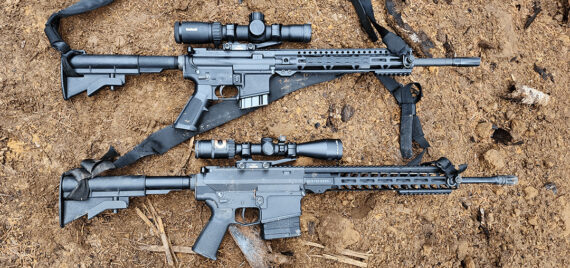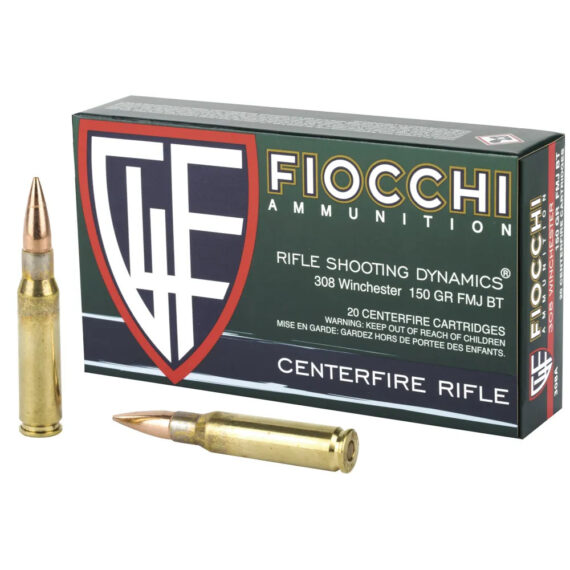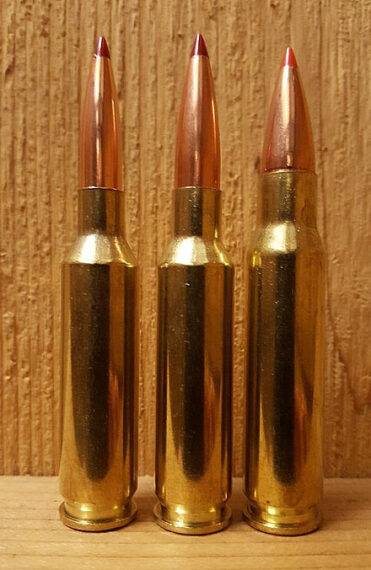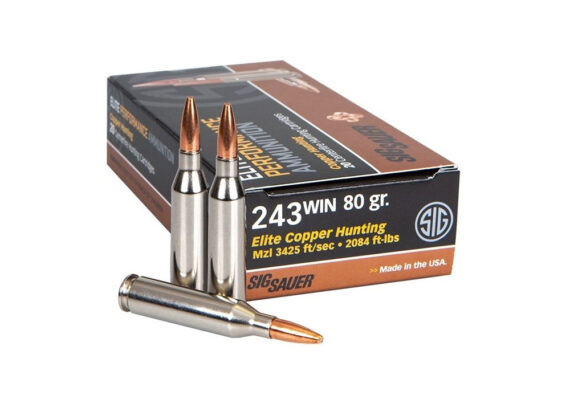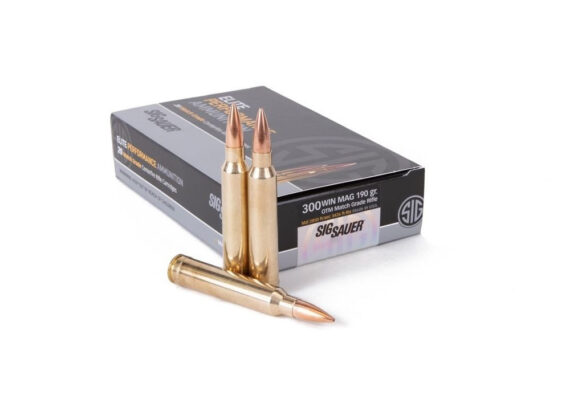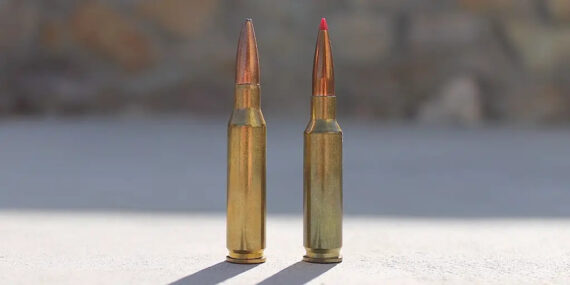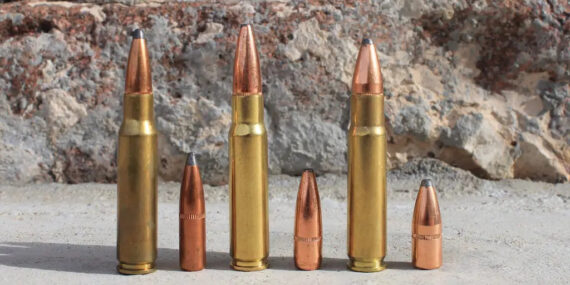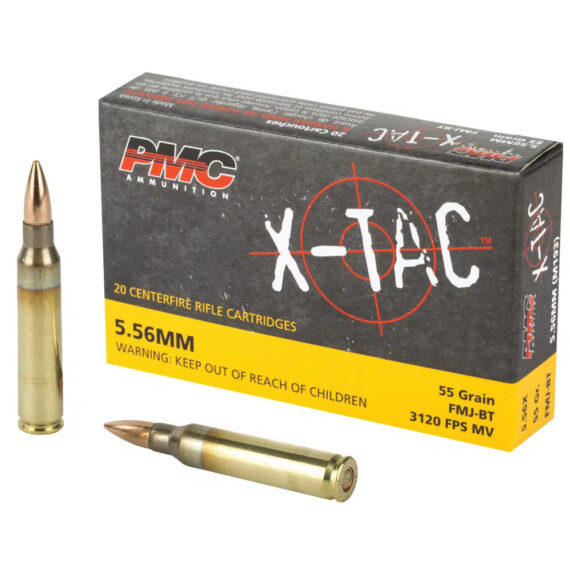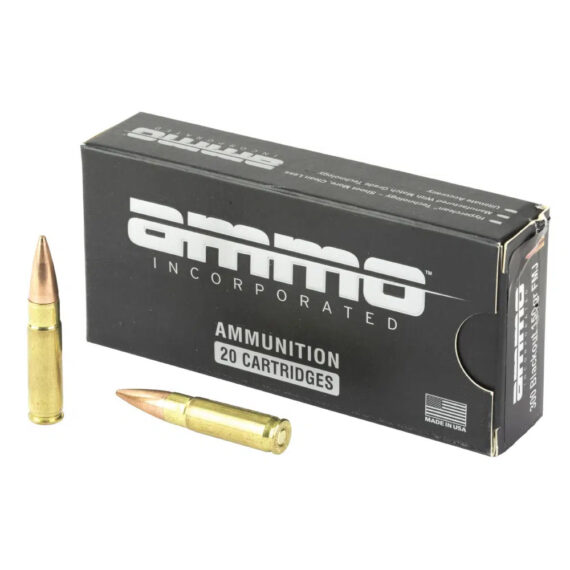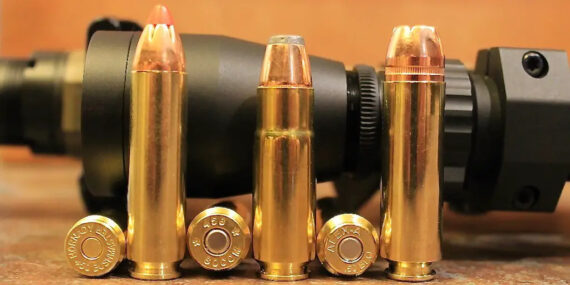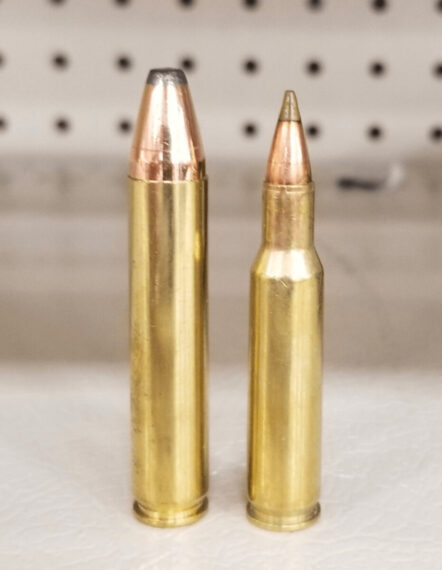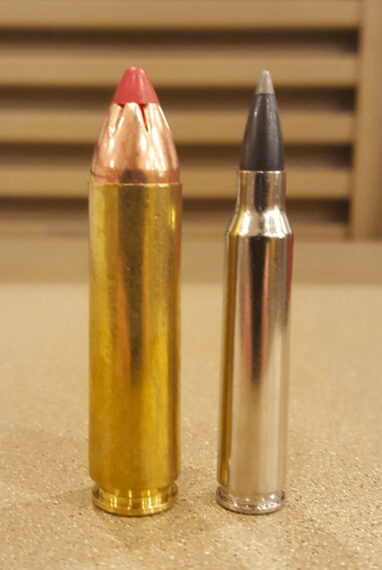AR-15 vs. AR-10: What’s The Difference? [Ultimate AR Rifle Guide]
There are a bunch of different numbers that come after AR these days. AR-9, AR-10, AR-15, AR-18, you name it, there’s an AR out there for that number category.
The AR-15 is above, and the AR-10 is below. Source: warnescopemounts
Right now, for this article, we will put the AR-15 vs. AR-10. We’ll discuss the differences between the two, as well as notable rifles chambered in these firearms, to help you understand and decide which would be best for you.
7.62×51, 5.56×45, and an AA battery. Source: Wikipedia
First, to clear up the confusion, we’ll go over the calibers associated with the AR-10.
What Calibers Are AR-10s Chambered In?
7.62×51 NATO/.308 Winchester
The 7.62×51 NATO/.308 Winchester is the most common chambering of the AR-10 platform and has been used in everything from hunting rifles to the famed M60 machine gun.
Fiocchi makes some quality ammo at often affordable prices.
It’s one of the finest calibers on the market for many different uses, from hunting to self-defense. Why? Because it’s relatively cheap, can be found in almost any big box gun store, and packs a great punch in a not-so-small package.
6.5 Creedmoor
6.5 Creedmoor has been gaining a lot of attention in the past few years. Multiple branches of the U.S. Military have adopted conversion kits that allow their rifles chambered in 7.62×51 to fire the 6.5 Creedmoor.
It was designed for long-distance target shooting. I guess they figured out it was useful for more than hitting paper.
6mm Creedmoor, 6.5 Creedmoor, and .308 Winchester. Source: Wikipedia
.243 Winchester Magnum
Gives you more firepower than a .223 Remington/5.56×45 but doesn’t punish you with crazy recoil. Good for hunting smaller and medium-sized game like deer or coyote. It does have more recoil than your normal .223 Remington, of course, but it is more ethical for hunting.
Sig Sauer .243 Winchester Ammo. Source: Sig Sauer
.300 Win Mag
Mostly used for taking down bigger game like elk or moose. However, it punishes your shoulder every time you fire it, so being in a semi-automatic rifle doesn’t make too much sense unless you’re planning on fighting a group of bears.
.300 Win Mag. Source: Sig Sauer
7mm-08 Remington
Another popular deer hunting round that offers similar performance to the .308 Winchester but has more recoil and faster bullets over distance.
7mm-08 Remington (left) and 6.5 Creedmoor (right). Source: thebiggamehuntingblog
.338 Federal
Loud, heavy recoil, and mostly used for hunting large game. It’s often hard to find available.
.338 Federal (left), .308 Winchester (middle) and .358 Winchester (right). Source: thebiggamehuntingblog
What Calibers Are AR-15s Chambered In?
.223 Remington/5.56×45
The most common chambering of the AR-15 is the 5.56×45, one of the longest-serving NATO calibers of all time. It began its service in the M16, which replaced the M14 (which is chambered in 7.62×51) in the 1960s.
It’s lightweight, fast, and versatile.
If you have an AR-15, we bet you’ve shot PMC X-Tac before
.300 Blackout
.300 BLK is still relatively new to the market. It’s meant to give shooters working in close quarters more power with a heavier caliber and shorter barrel. It’s also preferred over 5.56×45 for shooting suppressed.
It can be very expensive. Especially when you start getting into shooting subsonic rounds.
A black box for .300 Blackout seems fitting
.458 SOCOM
It’s pretty much like firing a .45 at 2,100 FPS. Not the most popular option due to the cost of ammo and scarcity, but it’s great in close-range engagements and suppressed. It was made for SOCOM, after all.
Actually, it was the .458 SOCOM that was meant to replace 5.56×45 after Special Forces complained about the lack of stopping power with their AR-15s.
From left to right: .450 Bushmaster, .458 SOCOM, .50 Beowulf. Source: thebiggamehuntingblog
.350 Legend
One of the youngest rounds in this article, the .350 Legend, shares many similarities with 5.56×45 as far as dimensions are concerned. Which led to this round becoming a popular chambering for the AR-15.
With a 160-grain bullet, .350 Legend flies at 2,300 FPS and hits the target with 1,879 lb-ft of energy. Say goodnight.
.350 Legend and 5.56×45. Source: Wikpedia
.450 Bushmaster
Developed for hunting big game out of a modern sporting rifle (like the AR-15), the .450 Bushmaster is one scary round. Intended less for self-defense and more for taking down elk and buffalo. It’s expensive, but you won’t have to shoot more than once.
The sound alone might scare the person to death.
.450 Bushmaster and .223 Remington. Source: Wikipedia
5.56×45 vs. 7.62×51 NATO
I know that was a lot of different ammunition, but we’re going to focus on 5.56×45 and 7.62×51 for this article since they are the most common chamberings for their respective platform.
I’ll keep it simple and use a bulleted list, starting with 5.56×45. Remember, we’re comparing them.
5.56×45
- Cheaper
- Lighter
- Flies faster
- Carry more rounds (since it’s lighter)
5.56×45 has been in service with the U.S. Military for quite some time. Although it wasn’t a huge hit when it first hit the fields in Vietnam, the round went through some changes and became one of the longest in-service rounds to date.
What it lacks in stopping power, it makes up for in portability and accuracy.
7.62×51
- Superior firepower
- Heavier
- More expensive
- More versatile
The big kahuna 7.62×51 is not one to laugh at when it comes to self-defense or all-out combat. To this day, it is still being used in sniper rifles and machine guns within the U.S. Military.
If I were to be dropped in an area where I had to survive against enemy fighters, then I would choose the 7.62×51 for its renowned stopping power over distance and, of course, up close.
Which One Is Better For You?
This boils down to personal preference and what you’re going to be using the round for. For self-defense, I’d opt for 5.56×45 since it’s easier to use, cheaper to train with, and has widespread availability.
If I were building an SHTF rifle, I’d choose 7.62×51 since the likelihood of me fighting against someone with body armor is likely, and 5.56×45 may not be enough. It’s also more useful in taking down larger game like buck and elk, which would be useful for food.
To determine which is better for you, think of what you’re after. If it’s self-defense, choose the 5.56×45. For all other things, including self-defense, the 7.62×51 is a viable option but is heavier and more expensive.
Final Thoughts
Remember, most AR platform firearms can be converted to shoot a different round fairly easily. So if you choose an AR-15 chambered in 5.56×45, you’re not going to be stuck with that and only that. Regardless of which you go with, be sure to train with it.
Be good and take care.
